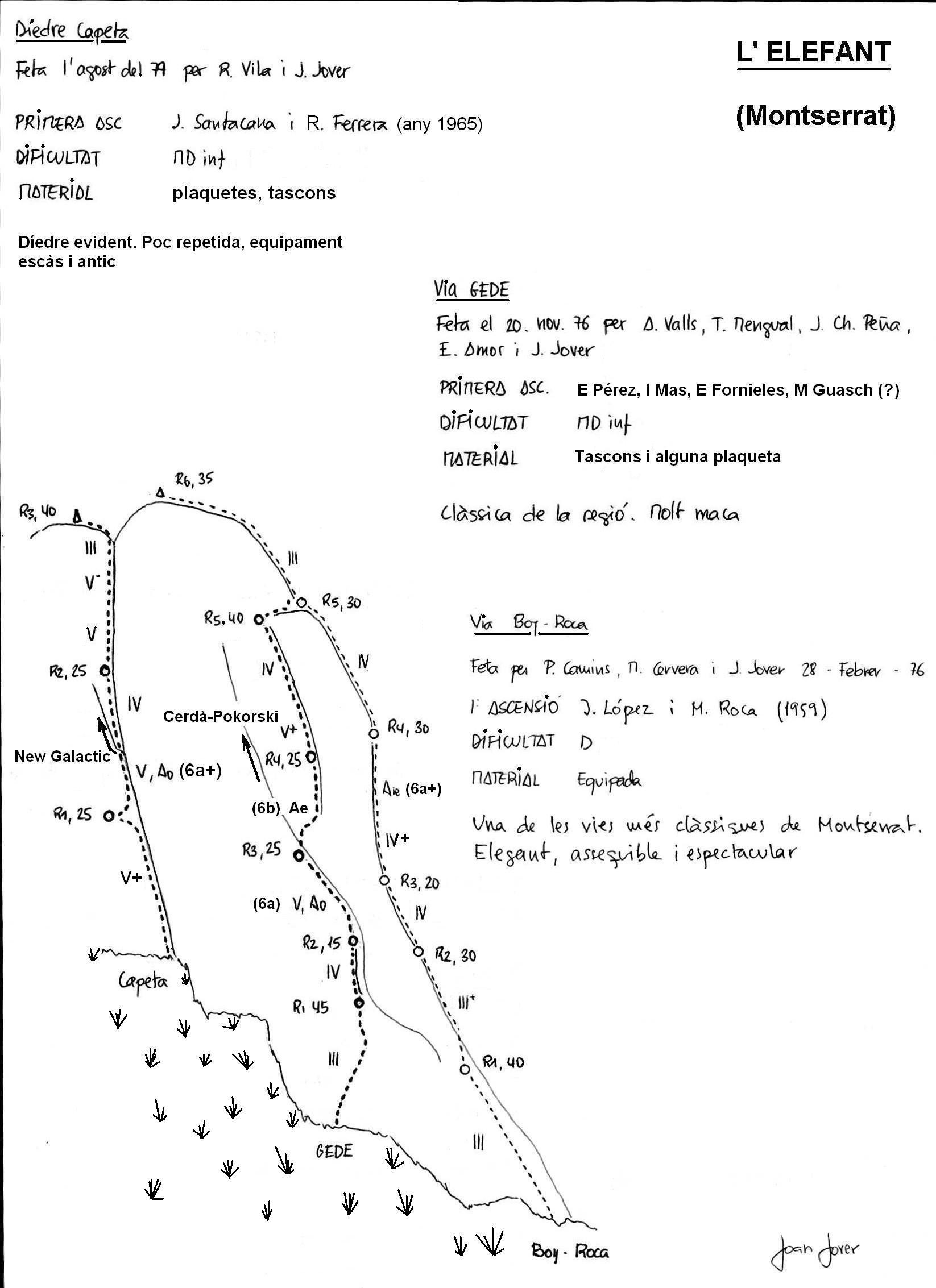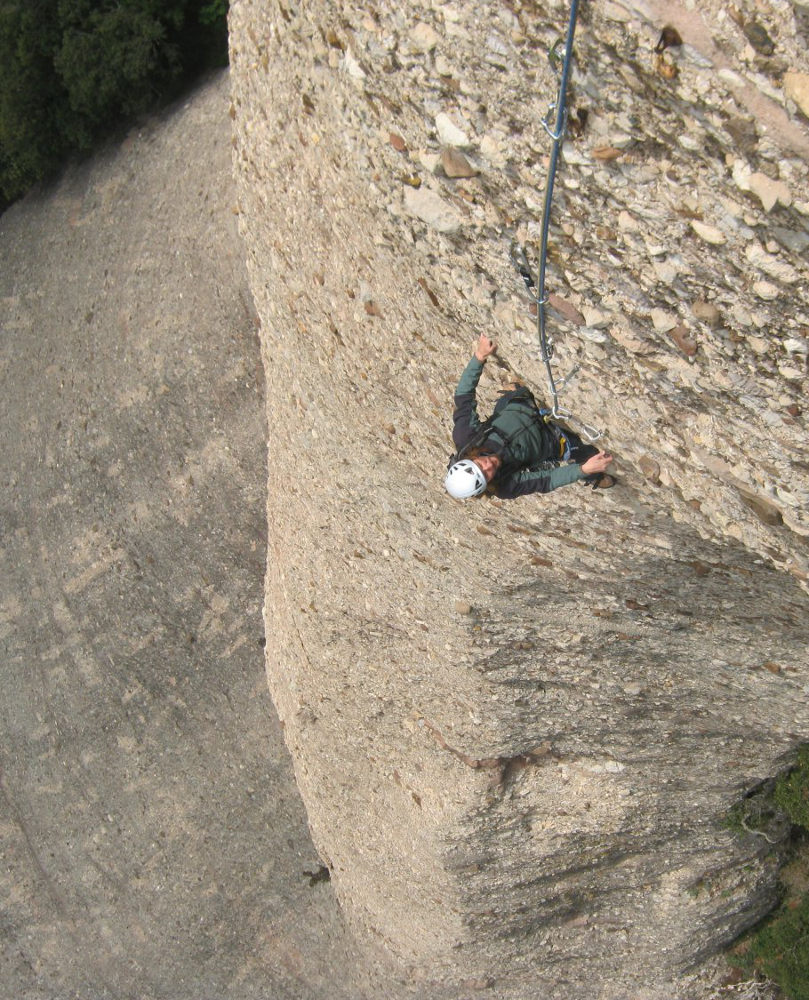TOPO
G.E.D.E à l’Elefant, Sant Benet, Montserrat, Spain

Montserrat's great classic. In the heart of the Sant Benet sector, this magnificent route climbs the south-east side of the gigantic trompe de l'Elefant, one of the massif's most characteristic needles. Very aerial, with a rather exposed 3rd and 4th pitch, the atmosphere is truly impressive. Equipment is uneven, with some pitches very sparsely equipped, including the first 35m pitch without a single nail, and others sufficiently equipped to pass as active'. You'll need to bring some gear not only to pass the actif' at the start of L4, but also to protect the relay exit at L5, with a 6a pitch that is totally unprotected. You can also attack the trompe via the Boy Roca, just next door, on the east face this time, also a very beautiful route, very well equipped from start to finish.
Technical summary
Access to the place
From Barcelona, take the A2 to Montserrat, exit after Le Bruc at the Grand Hotel. Shortly afterwards, turn off towards Montserrat and the monastery. The winding road passes through Can Maçana at the western end of the massif. After the pass, turn right to follow the north face. Pass the Santa Cecilia refuge and continue to the monastery. Park before entering the monastery or pay 5 euros to park inside.
Itinerary description
Hiking to the start 1h
Cross the monastery and, at the end, take the GR4 up to Pas dels francesos. At plaça de Santa Anna, fork right (follow the GR) and further up take the first turning on the left towards the Sant Benet refuge. Above, on the right, you'll see the Elefant and its trunk, not to be confused with La Momia on the right. Take the path to the right, about ten metres before the refuge. You'll pass under a ruined stone and brick gate. Follow the path and a little further on, fork left again towards the house of the hermit of Sant Salvador (indicated on a stone). The path winds its way up through the woods, and at the last bend before reaching the hermit's house (set into the rock), this is the starting point for the GEDE.
Course
The route, opened in 1969, faces south-east and is 155m long in 6 pitches (35m, 15m, 25m, 20m, 35m, 30m). The equipment is very uneven, with points widely spaced on the easy side. Bring 12 quickdraws, a ladder for the A1e if necessary, and a few small belayers to protect the rest when possible. Free climbing level 6b or 6a/A1e.
L1 (35m, IV)
This first pitch is totally free! Not a nail to be secured. It's a typical Montserrat climb, with a slight incline, but it's not long before the gas starts flowing, and even if it's not difficult and the grip is at its best, it's pretty committed! As a result, the route is free all the way to the belay, which is located at the level of a horizontal crack, but well to the right below the fault that can be seen above. Thrills are guaranteed and beware of slipping.
L2 (15m, V)
Very few nails here too, and we have to climb above the small boulder that comes loose to reach belay no. 2. You'll find yourself right below the large, vertical, skewed fault that runs upwards to the left!
L3 (25m, 6a)
On this pitch, the equipment, though old, is comfortable, with even a handle to pass over in case of difficulty. It's a smooth climb with very few handholds, except at the start of the fault where there are a few holes to grab. The end of the pitch is tighter, with a 6a exit to the belay.
L4 (20m, 6b/Ae1)
Overhanging start and traverse to the relay exit with two steps in 6b. We take the opportunity to test the ladders. The passage goes very well in artificial, with a few pulls to get out on the other side of the rock. Next, it's IV but with very few nails to reach a small grove in the hollow of the rock where we can install the belay on the trees in a comfortable position. Splendid views and over 100m underfoot.
L5 (35m, 6a)
The exit from the grove is a slight overhang in 6a with a small dihedral to negotiate away from the fault. We use a quickdraw to pull ourselves up and finally exit into the fault, which continues to climb vertically in V and then IV. The belay points get further and further apart! sometimes more than 10m without a nail, but possible protection At the end of the crack, we find the belay a little to the left, just below a dome that announces the summit.
L6 (30m, IV+)
Here we went right, traversing free for more than 15m before finding a plate at the bend in the rock. The route then climbs straight up to the summit.
Back
Very easy on the west side, descending through a small canal and then up a rock face to find the path leading to the hermit's house. Then take the same path in the opposite direction.




















Leave a Reply